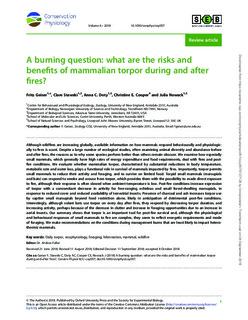| dc.contributor.author | Geiser, Fritz | |
| dc.contributor.author | Stawski, Clare | |
| dc.contributor.author | Doty, Anna | |
| dc.contributor.author | Christine, Cooper | |
| dc.contributor.author | Nowack, Julia | |
| dc.date.accessioned | 2019-09-06T06:52:23Z | |
| dc.date.available | 2019-09-06T06:52:23Z | |
| dc.date.created | 2018-12-11T11:23:47Z | |
| dc.date.issued | 2018 | |
| dc.identifier.citation | Conservation Physiology. 2018, 6 (1), 1-12. | nb_NO |
| dc.identifier.issn | 2051-1434 | |
| dc.identifier.uri | http://hdl.handle.net/11250/2612845 | |
| dc.description.abstract | Although wildfires are increasing globally, available information on how mammals respond behaviourally and physiologically to fires is scant. Despite a large number of ecological studies, often examining animal diversity and abundance before and after fires, the reasons as to why some species perform better than others remain obscure. We examine how especially small mammals, which generally have high rates of energy expenditure and food requirements, deal with fires and post-fire conditions. We evaluate whether mammalian torpor, characterised by substantial reductions in body temperature, metabolic rate and water loss, plays a functional role in survival of mammals impacted by fires. Importantly, torpor permits small mammals to reduce their activity and foraging, and to survive on limited food. Torpid small mammals (marsupials and bats) can respond to smoke and arouse from torpor, which provides them with the possibility to evade direct exposure to fire, although their response is often slowed when ambient temperature is low. Post-fire conditions increase expression of torpor with a concomitant decrease in activity for free-ranging echidnas and small forest-dwelling marsupials, in response to reduced cover and reduced availability of terrestrial insects. Presence of charcoal and ash increases torpor use by captive small marsupials beyond food restriction alone, likely in anticipation of detrimental post-fire conditions. Interestingly, although volant bats use torpor on every day after fires, they respond by decreasing torpor duration, and increasing activity, perhaps because of the decrease in clutter and increase in foraging opportunities due to an increase in aerial insects. Our summary shows that torpor is an important tool for post-fire survival and, although the physiological and behavioural responses of small mammals to fire are complex, they seem to reflect energetic requirements and mode of foraging. We make recommendations on the conditions during management burns that are least likely to impact heterothermic mammals. | nb_NO |
| dc.language.iso | eng | nb_NO |
| dc.publisher | Oxford Academic | nb_NO |
| dc.relation.uri | https://academic.oup.com/conphys/article/6/1/coy057/5127128 | |
| dc.rights | Navngivelse 4.0 Internasjonal | * |
| dc.rights.uri | http://creativecommons.org/licenses/by/4.0/deed.no | * |
| dc.title | A burning question: what are the risks and benefits of mammalian torpor during and after fires? | nb_NO |
| dc.type | Journal article | nb_NO |
| dc.type | Peer reviewed | nb_NO |
| dc.description.version | publishedVersion | nb_NO |
| dc.source.pagenumber | 1-12 | nb_NO |
| dc.source.volume | 6 | nb_NO |
| dc.source.journal | Conservation Physiology | nb_NO |
| dc.source.issue | 1 | nb_NO |
| dc.identifier.doi | 10.1093/conphys/coy057 | |
| dc.identifier.cristin | 1641554 | |
| dc.description.localcode | © The Author(s) 2018. Published by Oxford University Press and the Society for Experimental Biology. This is an Open Access article distributed under the terms of the Creative Commons Attribution License (http://creativecommons.org/licenses/by/4.0/), which permits unrestricted reuse, distribution, and reproduction in any medium, provided the original work is properly cited. | nb_NO |
| cristin.unitcode | 194,66,10,0 | |
| cristin.unitname | Institutt for biologi | |
| cristin.ispublished | true | |
| cristin.fulltext | original | |
| cristin.qualitycode | 1 | |

